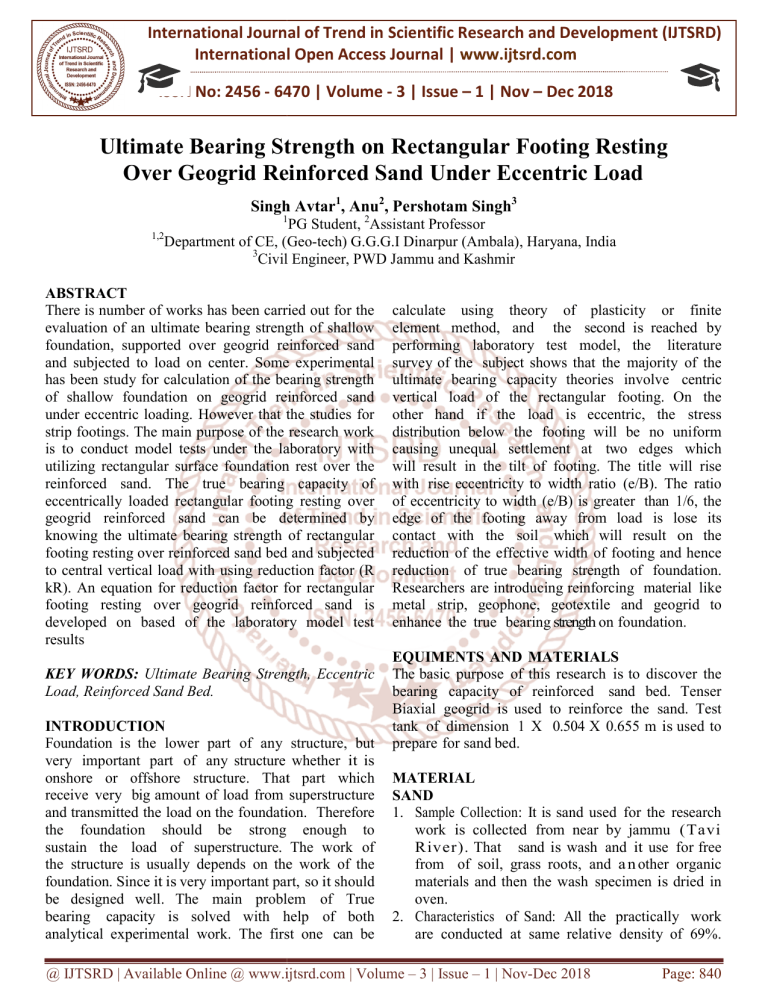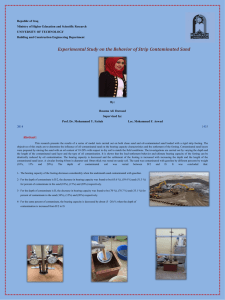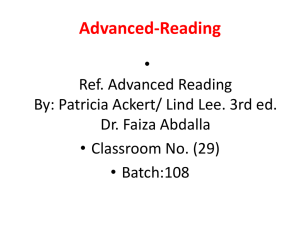
International Journal of Trend in Scientific Research and Development (IJTSRD)
International Open Access Journal | www.ijtsrd.com
ISSN No: 2456 - 6470 | Volume - 3 | Issue – 1 | Nov – Dec 2018
Ultimate Bearing Strength on Rectangular Footing Resting
Over Geogrid Reinforced Sand Under Eccentric Load
Singh Avtar1, Anu2, Pershotam Singh3
1
1,2
PG Student, 2Assistant Professor
Department of CE, (Geo
(Geo-tech) G.G.G.I Dinarpur (Ambala),, Haryana,
Haryana India
3
Civil Engineer, PWD Jammu and Kashmir
ABSTRACT
There is number of works has been carried out for the
evaluation of an ultimate bearing strength of shallow
foundation, supported over geogrid reinforced sand
and subjected to load on center. Some experimental
has been study for calculation of the bearing strength
of shallow foundation on geogrid reinforced sand
under eccentric loading. However that the studies for
strip footings. The main purpose
se of the research work
is to conduct model tests under the laboratory with
utilizing rectangular surface foundation rest over the
reinforced sand. The true bearing capacity of
eccentrically loaded rectangular footing resting over
geogrid reinforced sand can
an be determined by
knowing the ultimate bearing strength of rectangular
footing resting over reinforced sand bed and subjected
to central vertical load with using reduction factor (R
kR). An equation for reduction factor for rectangular
footing resting over
er geogrid reinforced sand is
developed on based of the laboratory model test
results
KEY WORDS: Ultimate Bearing Strength, Eccentric
Load, Reinforced Sand Bed.
INTRODUCTION
Foundation is the lower part of any structure, but
very important part of any structure whether it is
onshore or offshore structure. That part which
receive very big amount of load from superstructure
and transmitted the load on the foundation. Therefore
the foundation should be strong enough to
sustain the load of superstructure. The work of
the structure is usually depends on the work of the
foundation. Since it is very important part, so it should
be designed well. The main problem of True
bearing capacity is solved with help of both
analytical experimental work. The first one can be
calculate using theory of plasticity or finite
element method, and the second is reached by
performing laboratory test model, the literature
survey of the subject shows that the majority of the
ultimate bearing capacity theories involve centric
vertical load of the rectangular footing. On the
other hand if the load is eccentric, the stress
distribution below the footing will be no uniform
causing unequal settlement at two edges which
will result in the tilt of footing. The title will rise
with rise eccentricity to width ratio (e/B). The ratio
of eccentricity to width (e/B) is greater than 1/6, the
edge of the footing away from load is lose its
contact with the soil which will result on the
reduction of the effective width of footing and hence
reduction of true bearing strength of foundation.
Researchers are introducing reinforcing material like
metal strip, geophone, geotextile and geogrid to
enhance the true bearing strength on foundation.
EQUIMENTS AND MATERIALS
The basic purpose of this research is to discover the
bearing capacity of reinforced sand bed. Tenser
Biaxial geogrid is used to reinforce the sand. Test
tank of dimension 1 X 0.504 X 0.655 m is used to
prepare for sand bed.
MATERIAL
SAND
1. Sample Collection: It is sand used for the research
work is collected from near by jammu (Tavi
River) . That sand is wash and it use for free
from of soil, grass roots, and a n other organic
materials and then the wash specimen is dried in
oven.
2. Characteristics of Sand: All the practically work
are conducted at same relative density of 69%.
@ IJTSRD | Available Online @ www.ijtsrd.com | Volume – 3 | Issue – 1 | Nov-Dec
Dec 2018
Page: 840
International Journal of Trend in Scientific Research and Development (IJTSRD) ISSN: 2456-6470
The overall average unit weight of sand on the
relative density is 1.46g/cc and internal friction
angle is find out to be 40.90 by shear direct
test of the relative density.
Table2. Properties of the geogrid
Parameters
Value
Polymer
Polypropylene Pp
Tensile strength at 2% strain 7 KN/m
Table.1: Geotechnical Property of Sand
Property
Value
Tensile strength at 5% strain 14 KN/m
Aperture size (W)
39*39 mm
Specific gravity (G)
2.64
Aperture shape
Square
Effective particle size (D10)
0.33mm
Rib width (w)
1.1 mm
Mean particle size (D50)
0.455mm
Junction strength
95%
(D60)
0.47mm
(D30)
0.42mm
Coefficient of uniformity (Cu)
1.424
Coefficient of curvature (Cc)
1.137
Maximum unit weight
14.87 kN/m3
Minimum unit weight
13.42kN/m3
Angle of internal friction (degree) 40.90
Maximum void ratio (emax)
0.929
Minimum void ratio (emin)
0.741
GEOGRID
The shap of geogrids is the separate type of
geosynthetics
designed
for
reinforcement.
Geogrids is the categorized by a relatively high tensile
strength and a same distributed group of big
openings in between longitudinal and transverse rib.
The openings are known aperture. That openings
allow sand particle on both side of the mounted
geogrid to come on the direct contact which rise the
interaction between the geogrid and sand.. On the
base of strength direction, geogrids is classified like
Uniaxial and Biaxial while classified like Rigid and
Flexible basis on rigidity. In present studyg geogrid
is used to model test is biaxial flexible geogrid whose
physical characteristics is shown in Table 3.2.
Figure 1 Flexible Geogrid
TEST TANK
The size of the tank is made up on the base of IS
code and from the result of some literature. IS 18881962 said that lowest size shell be at least 5 times
the wide of test plate to develop the full failure
zone without any interference to side. Due to the
tank size, there is some scale effect which will
influence the ultimate bearing strength of footing
resting over geogrid reinforced bed sand. factor
(RKR) is reduction factor is defined as:
(1-
( )
(
)
)
Where q uR(e) and q uR(e=0) are the ultimate
bearing strength of reinforced bed sand under
eccentric and centric loading respectively.
EQUIPMENT USED
STATIC LOADING UNIT
A hydraulically operated static loading unit is
used to apply the load over the foundation during
test. The shaft is supported with horizontal beam
which supply the reaction on the shaft during
application of load.
PROVING RING
Proving ring of 20kN, 25kN, 50kN & 100kN are
use during practically work to measure the actual
applied load over the foundation during the
practicallyt work. The top of proving ring is
connected with the movable shaft of static loading
unit on the other hand the bottom is in connected
with the metallic ball which is resting over the
footing
DIAL GAUGE
Two number of dial gauge which is east to measure
settlement up to 50mm with least count of 0.01mm
is used during the practically work. Needle of the
@ IJTSRD | Available Online @ www.ijtsrd.com | Volume – 3 | Issue – 1 | Nov-Dec
Dec 2018
Page: 841
International Journal of Trend in Scientific Research and Development (IJTSRD) ISSN: 2456-6470
dial gauge is placed over the two diagonally at
adjacent corner of the footing. Magnetic basis
which is supported with test tank is used to support
the dial gauge.
MODEL FOOTING
The thickness of Model test footing 3cm made up
of mild steel are used for experimental work. A
1cm deep circular grove is made to hold the metallic
ball on one face of the footing at center and an
eccentricity of 0.05B, 0.1B & 0.15B from the centre
of the alone footings. Sand is use while the side of
footing with the helped of epoxy glue to make it
rough therefore that friction
in between
foundation and foot of soil can developed on
application ofload
MODEL TEST AND METHODOLOGY
To study the bearing strength of eccentrically loaded
foundation, laboratory model test are performed
over rectangular footing resting on be d sand
reinforced with numbers of layers geogrid. Model
test has performed over sand remolde on one
density, foot and aneccentricity varied from 0 to
0.15B and number of reinforcement varied as 0,
2, 3 & 4
PLACEMENT OF GEOGRID
On the case of reinforced sand bed, it is an essential
to decide the magnitude of u/B and b/B to take the
more benefit in the bearing strength of reinforced
sand. After t h e n through many literature, it has
been found that (u/B)cr for strip foundations vary
between 0.25 and 0.5, (b/B)cr is 8 and 4.5 for strip
footing and square foot respectively and (h/B)cr lies
between 0.25 to 0.4.
Figure 4.2 Placement of geogrid during
experiment.
RESULTS AND ANALYSIS
Load tests have been completely on model
rectangular of size footings like 10cmx18cm and
9cmx28cm resting over unreinforced as well as
reinforced sand bed with eccentricity varying from
0.0 to 0.15B. The true bearing capacity for each test
is determined from load settlement curve using
tangent intersection method.
BEARING STRENGTH OF UNREINFORCED
SAND
MODEL TEST RESULT
Results of load test have been draw in term of load
settlement curve as shown in Figure 5.1 and 5.2 for
footing size 10x18 cm (B/L=0.55) and 9x28 cm
(B/L=0.32 respectively. From graph, it is
observed that true bearing capacity less like
eccentricity width ratio (e/B )and also increases in
the total settlement at failure load decreases as
eccentricity width ratio (e/B) increases. By compare
the graph shown in Figure 5.1 and 5.2, it can also
be concluded that the Ratio of width to length (B/L)
decreases, load carrying capacity of footing increases
Figure 4.1 Cross-section
section showing sand bed and
multiple number of reinforcement
Figure4. Load-settlement
settlement curve of bed
unreinforced sand bed (B/L=0.55)
@ IJTSRD | Available Online @ www.ijtsrd.com | Volume – 3 | Issue – 1 | Nov-Dec
Dec 2018
Page: 842
International Journal of Trend in Scientific Research and Development (IJTSRD) ISSN: 2456-6470
Figure5 Load-settlement
settlement curve of unreinforced
sand bed (B/L=0.32)
Figure 8 Load-settlement
settlement curve for B/L=0.55 &
N=4 and different e/B ratio
STRENGTH
BEARING
OF
GEOGRID
REINFORCED SAND
MODEL TEST RESULT
The Laboratory model tests have been preform
with using rectangular foot with B/L=0.55 & 0.32
resting over the geogrid reinforced sand. This sand is
reinforced by place multilayer (N=2, 3, 4) geogrids
with df/B ratio equals to 0.6, 0.85 & 1.1, where dfis
the depth of lower most geogrid layer from bottom of
footing and B is the width of footing. Thae load is
applied centrally as well as eccentrically on the
model foot use static loading machine. The
Settlement corresponding to each load increment
have been write down and load settlement curve
have been plotted.
SUMMARIZED RESULTS AND SCOPE OF
FUTURE WORK
There is a number of laboratory model tests has been
conducted to find the ultimate load bearing capacity
of rectangular model footings resting on geogrid
reinforced sand and subjected to vertical an
eccentric load. All the tests has been conducted for
footing resting over the surface.
Following is the summarized results of present
research work.
An ultimate
bearing
strength
of
the
foundation for un-reinforced
reinforced and reinforced
soil decreases with the increase in eccentricity
ratio i.e. e/B.
An ultimate bearing strength of the foundation
increases with the increase in number of
reinforcement layer.
Reduction factor for the footing with B/L=0.55 &
0.32 has been derived alonely and then
combined toget a simple general equation to
reduction factor for rectangular footing as shown in
Equation 5.11.
Figure6. Load-settlement
settlement curve for B/L=0.55 &
N=2 and different e/B ratio
Figure7. Load-settlement
settlement curve for B/L=0.55 &
N=3 and different e/B ratio
SCOPE OF FUTURE WORK
On the present study the research work is related to
ultimate bearing strength of eccentrically loaded
rectangular footing with B/L = 0.55 & 0.32 resting on
reinforced sand bed. During time constraint, an other
aspects similar to shallow foundations can not be
studied. The work for should consider the below
mentioned points:
REFERENCES
1. Terzaghi, K. (1943). Theoretical Soil Mechanics,
Wiley, New York.Meyerhof G.G. (1953). “An
Investigation for the Foundations of a Bridge on
Dense
Sand.”
Proceedings
of
the
@ IJTSRD | Available Online @ www.ijtsrd.com | Volume – 3 | Issue – 1 | Nov-Dec
Dec 2018
Page: 843
International Journal of Trend in Scientific Research and Development (IJTSRD) ISSN: 2456-6470
Soil
3rdInternational
Conference
on
Mechanics and Foundation Engineering, 2, pp.
66-70
2. Meyerhof G. G. (1963). “Some
Some recent
research
on the
bearing
capacity of
foundation Canadian Geotech. J. 1(1), pp 16
3. Prakash, S., Saran, S. (1971). “Bearing capacity of
eccentrically loaded footings.Journal
Journal of Soil
Mechanics and Foundation, ASCE, 97(1), pp. 95118.
4. Vesic, A.S. (1973). “Analysis of ultimate loads
of shallow foundations.” J. of Soil Mech. and
Found. Div., ASCE, 99(1), pp. 45-73.
73.
5. Purkayastha, R.D., Char, R.A.N. (1977).
“Sensitivity analysis for eccentrically loaded
footings.”J.Geotech.Eng. Div., ASCE, 103(6), 647
6. Highter W. H., Anders J. C. (1985).
“Dimensioning Footing Subjected to Eccentric
Load.” Journal of Geotechnical Engineering Vol
111, No.5
7. Khing, K. H., Das, B. M., Puri, V. K., Cook, E. E.,
Yen, S. C. (1993). “The bearing
capacity of
strip
foundation
on
geogrid
reinforced
sand.” Geotextile
and Geomembrane 12,
pp351-361
8. Das, B. M., Omar, M. T. (1994). ““The effect of
foundation width on model tests for the bearing
capacity
of
sand
with
geogrid
reinforcement.” Geotechnical and Gelogical
Engineering 12, pp133-141
141
9. Yetimoglu T., Jonathan T. H. W., Saglamer
A. (1994). “Bearing capacity of rectangular
footings
on
geogrid-reinfoced
geogrid
sand.”
Journal of Geotechnical Engineering, ASCE,
120, 12.
10. Zhao, A. (1996). “Failure
Failure Load on Geosynthetic
Reinforced Soil Structure.”
Structure. Geotextile and
Geomembranes 14, pp 289-300
289
11. Huang, C.C., and Menq, F.Y.(1997). “DeepFooting and Wide-Slab effects in reinforced
sandy ground.” Journal of Geotechnical
and
Geoenviornmental Engineering, ASCE,
123(1), pp. 30-36.
12. Dash,
Krishnaswamy,
N.
R.,
S. K.,
Rajagopal, K. (2001). “Bearing capacity of
strip
footings
supported
on
geocellreinforced
sand.”
Geotextiles
and
Geomembranes, 19, pp. 235-256
235
13. Shin, E. C., Das,
Ataler, C., (2002).
fondation
on
Geotechnical and
pp169-180.
B. M., Lee, E. S., and
“Bearin
Bearin capacity of strip
geogrid-reinfoced
geogrid
sand.”
Geological Engineering 20:
@ IJTSRD | Available Online @ www.ijtsrd.com | Volume – 3 | Issue – 1 | Nov-Dec
Dec 2018
Page: 844





